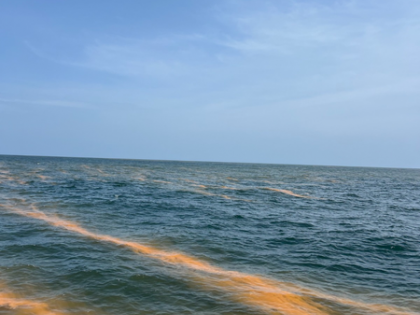Monsoon runoff, coastal changes trigger bioluminescent red tides off Kerala: CMFRI
By IANS | Updated: August 26, 2025 15:55 IST2025-08-26T15:49:11+5:302025-08-26T15:55:28+5:30
Kochi, Aug 26 ( IANS) Continuous monsoon-driven river runoff, coupled with changing coastal conditions, has triggered the recent bioluminescent ...

Monsoon runoff, coastal changes trigger bioluminescent red tides off Kerala: CMFRI
Kochi, Aug 26 ( IANS) Continuous monsoon-driven river runoff, coupled with changing coastal conditions, has triggered the recent bioluminescent red tide event along Kerala’s coast, the ICAR–Central Marine Fisheries Research Institute (CMFRI) has pointed out.
A field survey by the CMFRI’s Marine Biodiversity and Environment Management Division (MBEMD) found that heavy inflows from rivers during the monsoon enriched coastal waters with nutrients, creating favourable conditions for the bloom of Noctiluca scintillans, a large bioluminescent dinoflagellate often linked to such phenomena.
The institute’s latest observations, made in mid-August aboard the research vessel Silver Pompano, documented the bloom up to 40 km off Kochi and at depths of 40 metres.
Unlike earlier reports limited to nearshore waters, researchers this time recorded expansive patches, nearly two kilometres long and wide, drifting towards the coast.
The sea surface was streaked in vivid orange-red, with countless glowing particles scattered across the water.
The bloom was traced to the "red form" of Noctiluca scintillans, which lacks its photosynthetic partner, giving the waters their striking red-orange hue.
Since early August, bioluminescent red tides - known locally as 'Kavaru' - have been sighted along several Kerala beaches, including Koyilandy, Chavakkad, Edakazhiyoor, Nattika, Fort Kochi, Puthenthode, Purakkad, and Pozhikkara.
Although the phenomenon is not directly harmful to fisheries, CMFRI scientists warned of ecological impacts.
Fish generally avoid bloom-affected areas due to lower oxygen availability.
As Noctiluca feeds on diatoms, bacteria, plankton and organic matter, intense blooms may also disrupt the food chain, affecting larvae, juveniles and adult fish of commercially valuable species such as sardines and mackerel.
At the bloom site, dissolved oxygen levels were measured at 4.27 mg/L - significantly lower than the 6.25 mg/L at a nearby unaffected location.
"These events underscore the importance of continuous monitoring of coastal waters, particularly during the monsoon season. Changing environmental conditions could make such blooms more frequent and intense," CMFRI Director Dr Grinson George said.
Disclaimer: This post has been auto-published from an agency feed without any modifications to the text and has not been reviewed by an editor
Open in app